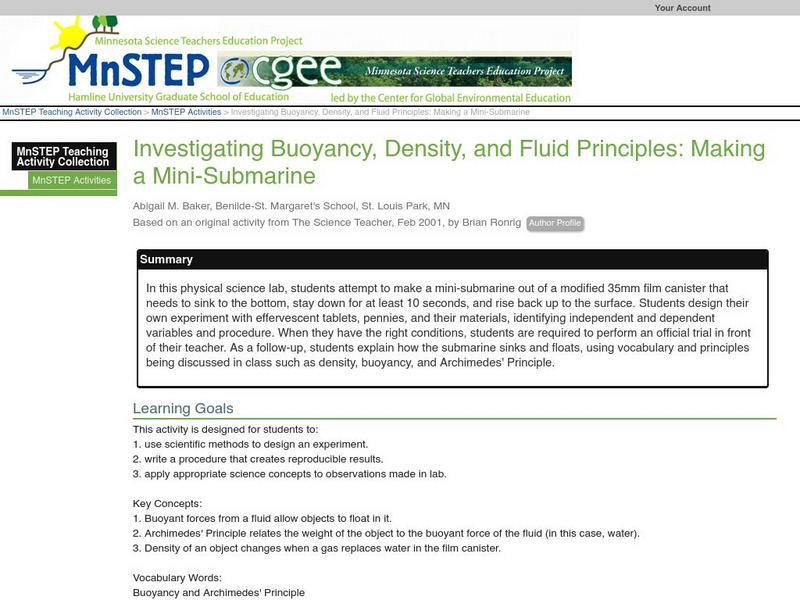Hi, what do you want to do?
Curated OER
WiTricity Explained
Students explain how electricity is transferred from source to load without actual wires connecting the two. In this physics lesson, students explore how wireless electricity was discovered. They cite practical applications of this...
Curated OER
I've Got That Sinking Feeling
Students design a simple boat and predict how much weight it can carry. They should also discover why objects float or sink and how this can be determined experimentally. A great lesson plan on buoyancy!
NOAA
What's New?
Biodiversity in some areas is more diverse than one might think. Using a two-day lesson, pupils consider the biodiversity of the Hudson Canyon and the characteristics of one organism. They begin with an analysis of the common earthworm...
Curated OER
Lessons from the Holocaust; Hitler's Germany
Students explore Nazi Germany by completing several worksheets. In this Adolf Hitler instructional activity, students identify Hitler's role in the holocaust, his role in the German community and his mindset. Students read the poem "The...
Curated OER
Beneath the Sea
Students build a model of a submersible that will allow them to explore ballasts and how they operate. In this hands on instructional activity students participate in an activity that shows them how to control buoyancy.
Curated OER
What In The World Are Swim Bladders and Why Are They Important
In this swim bladders learning exercise, students use a bowl, water, and balloons to make swim bladders, and answer short answer questions about them. Students answer 7 questions and interview someone who has been scuba diving.
Curated OER
The Magic School Bus Explores the Ocean
Pupils are introduced to "The Magic School Bus Explores the Ocean". They should have been studying the ocean. They have heard and read many books on the topic. This software will bring the ocean to life and provide information to enhance...
Curated OER
Diving Raisins
Students hypothesize and observe what occurs when raisins are dropped in a carbonated liquid. They examine buoyancy and how density effects ascent and descent.
Curated OER
Density - To Float or Not to Float? That is the Question!
Students investigate how to find the density of fluids and solids using math. Students also learn how to find the density of regular and irregular shaped objects.
Curated OER
George Herbert Walker Bush
In this American history worksheet, students read a biography about George Herbert Walker Bush and complete 8 multiple choice questions.
Curated OER
Graphical Determination of Density
Learners determine the density of metal shot by a graphical method using significant digits in making measurements and calculations. Students graph a seris of laboratory measurements and determine density from a mass verses volume graph.
Curated OER
Diving Raisins
Learners participate in a mini lab to explore density. In this density lesson students view a demonstration and answer questions.
Curated OER
Florida During World War II
Second graders list reasons why Florida was ideal for building military bases, then explain why America entered World War II. They list reasons why Florida was ideal for building military bases.
Curated OER
Colonial Geography: To and From Canada
Students identify the major geographic features of colonial New England. They explain the essential parts to a map and interpret journals to plot a journey. They discover the connection between geography and life.
Museum of Science
Museum of Science and Industry: Online Science: Design a Submarine
Become an engineer, and design a submarine that moves in the water like a real submarine. Try making it sink, float, and hover in the water.
Science Education Resource Center at Carleton College
Serc: Investigating Buoyancy, Density, and Fluid Principles: Make Mini Submarine
In this lab, students will use the scientific method to design an experiment that explains how/why a submarine floats and sinks.
Other
American Merchant Marine at War: u.s. Merchant Marine in World War Ii
Gives an excellent history of the sailing ships and sailors of the Merchant Marine in both the Atlantic and Pacific. Links on the page include many firsthand accounts of the sailors and their experiences during the war.
PBS
Pbs Teachers: Submarine Race Experiment
Balance the force of gravity with the force of the expanding gasses created by mixing baking soda and vinegar. Create a soda bottle submarine that sinks to the bottom of the bathtub and then rises back to the surface.
Science Bob Pflugfelder
Science Bob: Make a Cartesian Diver!
This site presents a procedure for creating a cartesian diver, a miniature submarine which rises or sinks depending upon the water pressure within a closed bottle. The site also introduces basic concepts of water and air pressure.
The History Cat
The History Cat: America Enters the Ring
Describes the events leading up to America's entry into World War I and the changes that took place in America soon after. These included legislation such as the Selective Service Act and the Espionage and Sedition Acts, protests by...
Curated OER
Reeko's Favorite Means Up Public Transportation!
With this simple experiment, one can replicate the sinking and rising of a submarine with a bottle filled with water and a pen cap.























